
This blog post should really be called, "tech bindings for dummies". Much of what is quoted below is info I have filtered from Wildsnow, Teton Gravity and the posters there. I have also read and reread the Dynafit manuals on the various versions of their bindings that I own and use on a regular basis.
But it has been only recently that I ever took the Dynafit style bindings seriously for anything but touring. Now they are the only style of binding I am usingskiing. Differing models tomatch my perceivedneeds and gear. I could be wrong on some of the details and others might well have a different experience or opinion. Please let me know if you see something wrong ( which is why I have been looking for info) or want to add to the info. Ski stuff is mind boggling these days. This is written simply as part of the process toeducate me. If it helps other climber/skiers to figure out a new winter boot/binding combo even better.
Brian's blog is a greatlook at some of the tech bindings available currently. Well worth the read.
http://www.getstrongergolonger.com/journal//1/20/light-and-fast-bindings.html
I'll focus on bindings I actually use on my small quiver of skis. Weight listed is ONE binding, not a pair.
Dynafit TLT Speed 335 grams

Dynafit TLT Speed w/ B&D top plates 269 grams

Dynafit TLT VERTICAL ST 402grams (no brake)

Dynafit Low Tech Race
124g with no screws (factory says 117 g)
La Sportiva RT 175 grams

So what does all those grams mean? On my Hi5 skis the difference between the La Sportiva RT binding and the Dynafit TLT Vertical?
it is aSEVEN OZ.per foot! Thechoice of the heavier TLT Vertical *might* be OK on a 188cm fat ski like the Hi5 that will see limited time with me pushing them up hill, (much as I love them going down) but it would not be a good choice imo on a shorter, lighter mountaineering ski used on technical ground going up and down..

So not all bindings are created equal.
The RT retails for: $749.95
*5-10 RV not DIN range 175 grams (no brake weight)The TLT Vertical retails for: $478.95 (price includes a ski brake)
*5-10 RV not DIN range 402grams (no brake weight)Dynafit TLT Speed is the "original". Now a classic, time tested and still as good as any of them imo. At 335 grams each, still a light weight compared to traditional down hill bindings. But heavy compared toa 135 gram race binding. But what binding isn't?
The Speed also hasall the *release options* that many prefer.Say what? Release options? Like, some have a release option and some don't? Well, yes, now that you ask. Some have a release option very similar toa typical downhillDIN rated ski binding and SOME DON'T!
That doesn't sound good does it?!
Some where on the Vallee Blancheor atGrand Montets last winter after a second pre-lease from having snow and ice on my boot soles,my partner that day said, "you need to lock your bindings." "Just pull up the toe piece lever."
It would have been better to just stop and clean off my boot in retrospect, which I did do. Buteven better would toactually know how Dynafit style bindings shouldwork!
Hint..??!! Locking the toes gives you something like a number of 17 DIN on the toe release of the tech style bindings.This isan important tech tip for all these bindings, by Mtn. Guide Mike Bromberg, from his web site:
"I regularly will lock my toe pieces a few clicks to insure that the pins are properly seated in the tech fittings. Once I’m confident that they are properly engaged/ice free, I push the lever back down to ski mode. I’m confident that nearly 100% of pre-release issues involving tech bindings are related to inattention during this step, and this is a simple way to verify proper attachment. This process has been much easier with the PLUM guide’s and I’m finding that I rarely have to bend down to help facilitate this process."
More of Mike's Plum Guide binding review and a link to his website at teh bottom of this blog post.
There is an optionto shed some of the weight from the Dynafit Speed by pulling off the original climbing plate and addinga pair of B&D Ski Gear top plates. Elevators are 86g per pair (3oz), plates 20g (.7oz)pair.
That will drop around66 grams per pair or 2.3 ounces. It all adds up when you start counting ounces. But it will also eliminateyour high touring position. Make sure your boots are up to the task before you make that change.
The real light weight in the bunch of bindings that I own isthe Dynafit is the Low Tech Race Auto. This binding is self locking,,,so you get something clsoe toa 7 DIN in the heel release and a 17 DIN in the toe. But I also keep them on short skis. I use them on two skis, a pair of 162cm and 167 cm skis. Skis that I always ski in control and in places I'd rather not drop a ski for any reason. At 124 gramsperbinding or right at 8.75 oz. per pair (screws not included). Both sets of my mountaineering ski with the Low Tech Race bindingscome in under6 lb total. Worth the trade off for me so far. No brakes of course. But I do use leashes if I am not running brakes.
"■Lou December 16th, 9:21 pm
"a ton of people in EU tour on this stuff. It’s very popular, especially in social groups where racing and super fitness are practiced. I’ve tried touring on some lightweight rigs and really don’t like the lack of ski brakes, but it seems a lot of people don’t care one way or the other about brakes. Most of those folks are such good skiers they rarely fall and hardly ever release from a ski. Lot’s of them ski with the toes locked. It’s actually gotten pretty crazy. Reminds me of telemarking at its peak in North America, e.g., all sorts of innovation, and who cares about safety release or ski brakes? Yeah, safety lateral release is over rated.
BTW, remember that with a locked “tech” type binding you can still release vertically at the heel, so perhaps that mitigates some of the risk of skiing with the toe locked"
http://www.wildsnow.com/2275/dynafit-tech-bindings-review/
"■Euro Rob December 17th, 4:15 am
"Apart from what Lou said about the race-style touring that’s increasingly common over here in Yurp (good skiers, lightweight gear and humans) it probably also makes a difference that virtually everyone with race bindings is on 150-164cm skis. They don’t get tangled as easily as longer ones when falling, so the risk of injuries is lower. Also people don’t go hucking cliffs with those sticks."
Here is another comment on the short ski issue more to the point:
http://www.vermontskisafety.com/vsropski2.php
"Opinion: Skiier/Rider Issues
Subject: Skiboards and other skis without release bindings.
Any ski, short or long, without a release system is potentially dangerous.
A current practice with the potential to dramatically increase the incidence of lower leg injuries is the proliferation of short skis with non-releasable bindings. A study we presented earlier this year demonstrated that lower leg injuries were four times more likely when using such products, than with conventional rental equipment incorporating releasable bindings. Since short skis are also available in combination with releasable bindings, there seems to be no reason to sell or rent such a product. Any ski, short or long, without a release system should be considered potentially dangerous and should not be sold or rented without both parties recognizing the increased risk of lower leg injury associated with its use."
*Carl Ettlinger - Adjunct Asst. Professor, College of Medicine, University of Vermont, Burlington, VT 05405, and President, Vermont Safety Research, Underhill Ctr., VT 05490
**Dr. Jasper Shealy - Professor, Department of Industrial and Manufacturing Engineering, Rochester Institute of Technology, Rochester, NY 14623
And is my own experience?
I have pre-leased from the Speeds set on really light weight settings. Not paying attention tomy boots soles was the issues. Both easily solved. No need to lock the toes if the binding is correctly adjusted and your boot soles and binding boot holes clean.
Now that I am paying attention to both settings and boot soles I have NOT had a pre-lease in the TLT, Speed, Raceor the RT. But I can also count on one hand the number of falls I took in . Not that I am such a good skierbut that I make every effort to ski in control.
The current Low Tech Race?I have been able to ski mysteepest lines to date and had the most fun skiing and touring, ever, on the low techbindings. I have also been doingsome limited side hill and lift skiing on the Low Tech Race bindingas well as touring. But that isn't a recommended use of that binding. And no question a titanium heel piece,bolt/springs, have no business being used there. It is simply a waste of good technology/titanium. Better used on JUSTrace day imo. At least till I get the steel replacement springs. But then how do you knowifyour bindings are reliable. Catch 22 for me.Steel is a better option there on my ski. I am no fly weight at 200# fullykitted out in ski gear. No pre-leases from any of these bindings, But all four styles of the bindings have come off when required. Even the Low Tech Race. Admittedly the Race release was a little on the "nervous side". Nervous because I was glad they DID release!
A interesting observation for me aboutusing race gear. If you are to take advantage of race technology you have to mimic much of the current race mind set. The LowTech race has no "flat" setting on the heel. You are either locked in for skiing or you have a mid height elevator lifting your heel. Nothing in-between. Seems like a engineering/design mistake to me not to have both a flat and a bump above for steeper skinning.Plum race binding heels are the same or a very similar set up BTW. So everyone but me seems to have the magic numbers on this.A little researchshows World Cup racers skating the flats....so it begins to make sense. Once I started skating and herringboning mild inclines I didn't notice the need for a "flat boot" as much. But with no down side or added weight involved to make a flat bootpossible on the Low Tech Race I still call that one a design flaw. Boot/foot angle not with standing. I'm likelyto use the same gear on Denali (Low tech race binding, TLT5 and a 167cm Hidden Peak ski) and I can't easily envisionskating any where betweenthe air stripand 11,000 feet. So I would really likea flat boot some times. But the point is, if you want to use the lightest and generally most efficient gear,be it clothing, ski, bindings or poles be prepared to make adjustments in your technique and maybe learn new skills as well. Fair trade...most of the time.....I think.
One thing that might make a difference that is not likely a race technique from what I have seen on videos. With a low tech you'll want to stay in control and NOT fall. Easier said than done. But if you choose a binding without full release values something to put in the back of your mind before it bites you, hard.
Now that I know what a "locked toe" means I admit to being a little nervous myself. But it is a road you'll likely not turn around on once you have carried and skied on a low tech binding. The weight saving and simplicity are addictive.
Luckily there are several new bindings, the RT and Plum's offerings, that will give youfull release values and a light weight binding as well. So you can choose what is important to you. I admit to finally balkingat the prices. The lightest low tech bindingsdid end upon some ofmy own gear. But they are quiver skis. The quiver allows me to choose what I ski and whatbinding I spend the most time going up hill on. Low techs work there. But hard for me not to I prefer a full lease binding now that the weights are coming down to rival the low techs. Plum in particular seems to have done the tech bindings at a new level of quality that hadn't been seen. More on the Plum bindingsin the links below.
 Three ofthe quiver with bindings that I think match my use of the ski.
Three ofthe quiver with bindings that I think match my use of the ski.I can't think of a sportwhere you pay this kind of $/per oz. ratio. Even pro level road bike parts don't compare. Race car partsand custom firearms aren't even in thatkind of price range.
But if the TLT5 Performance boot is any example the race technology will eventually filter down to everyoneand the consumer prices will drop as they do.
Although I have not skied on this binding yet,they are wellworth a critical look if you are in the market.
Plum, the company, the bindings and order info here:
http://www.fixation-plum.com/catalogue-fixations.php?lang=en
More on the Plum Race bindings here:
http://skitheory.blogspot.com//12/plum-race-135-145-185-bindings.html

More on the Plum Guide by Guide Mike Broomberg here:
http://www.mikebromberg.com/plum-guide-binding-review/

Here is a guy known for cranking his bindings to "full lock mode* and always being incontrol :)DIN of 12 ya think?
"GLEN PLAKE skiis the PLUM "Guide"!
Photo courtesy of Glenn Plank and the Plum web site.
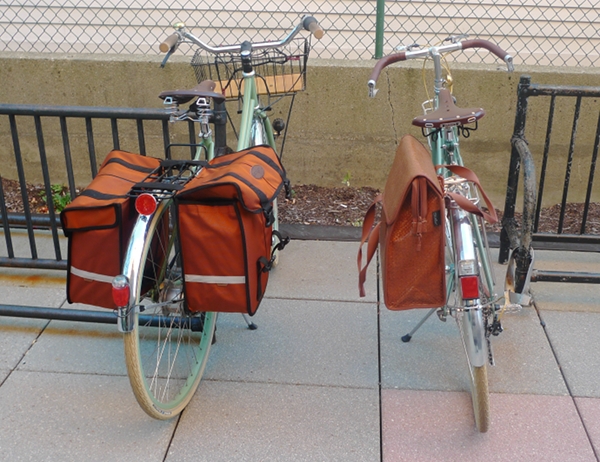 On a lovely Sunday afternoon in Boston, my Royal H. mixte ran into a cousin...an ANTLady's Boston Roadster of the same colour.
On a lovely Sunday afternoon in Boston, my Royal H. mixte ran into a cousin...an ANTLady's Boston Roadster of the same colour. I promise the ANT is not mine. But whoever it was built for certainly has a similar taste in bicycles.
I promise the ANT is not mine. But whoever it was built for certainly has a similar taste in bicycles.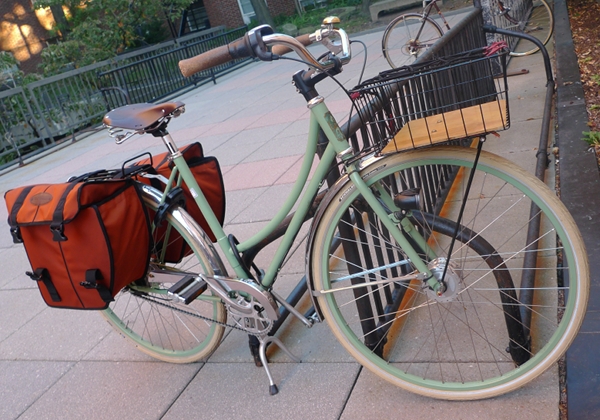 Sage green loop frame, cream Delta Cruiser tires, brown leather saddle, cork grips and huge copper panniers - I think the combination looks great. And notice that the rims are powdercoated the same colour as the frame.
Sage green loop frame, cream Delta Cruiser tires, brown leather saddle, cork grips and huge copper panniers - I think the combination looks great. And notice that the rims are powdercoated the same colour as the frame.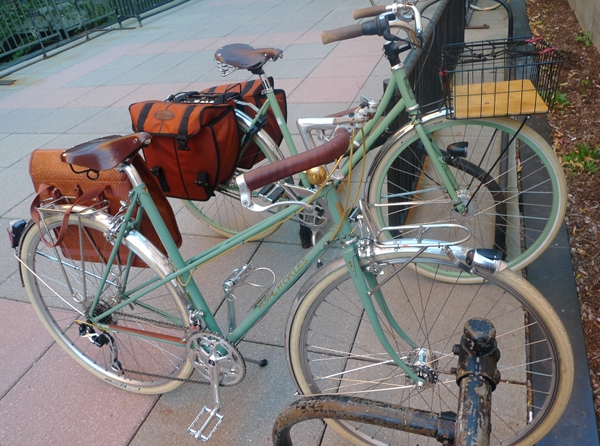 It's fairly accurate to say that my Royal H. and this ANT are related. Not only because both were made by Bostonian frame builders and have similar "complexions," but also because some time ago Mike Flanigan (of ANT) gave Bryan Hollingsworth (of Royal H.) the new-old-stock mixte lugs that made the construction of my bicycle possible.
It's fairly accurate to say that my Royal H. and this ANT are related. Not only because both were made by Bostonian frame builders and have similar "complexions," but also because some time ago Mike Flanigan (of ANT) gave Bryan Hollingsworth (of Royal H.) the new-old-stock mixte lugs that made the construction of my bicycle possible. Like my mixte, the ANT roadster was built with racks and dynamo lighting. Looking at the "cycling landscape" in Boston today, I think it is important to credit ANT for resurrecting the notion that transport bikes should be built with these features. I see more and more bicycles now with dynamo lighting, whereas as recently as a year ago people would stop and ask me why my front hub was so large, amazed when I would explain that the lights are powered by pedaling. And racks are now pretty much the norm on city bicycles, whereas a year or two ago they were an anomaly. ANTbikes, and the younger local builders whose work is influenced by them, played a crucial role in this change.
Like my mixte, the ANT roadster was built with racks and dynamo lighting. Looking at the "cycling landscape" in Boston today, I think it is important to credit ANT for resurrecting the notion that transport bikes should be built with these features. I see more and more bicycles now with dynamo lighting, whereas as recently as a year ago people would stop and ask me why my front hub was so large, amazed when I would explain that the lights are powered by pedaling. And racks are now pretty much the norm on city bicycles, whereas a year or two ago they were an anomaly. ANTbikes, and the younger local builders whose work is influenced by them, played a crucial role in this change. It is nice to live in a city that is home to so many excellent frame builders, and to spontaneously "meet" other local handbuilt bicycles. The bike pictured here was actually the second ANTI saw today. Earlier, I was stopped at an intersection and heard the cyclist behind me say "Sick bike! Where did you get it?" I started telling him aboutRoyal H. and handbuilt frames, then realised that he was riding a blackANT when he pulled up beside me. "Hey, yours is an ANT!" What a weird thing to bond over, bicycles. Encounters like these make me feel like a character out of a 1950s sitcom, where neighbours wave and smile to one another and the mailman whistles a happy tune.
It is nice to live in a city that is home to so many excellent frame builders, and to spontaneously "meet" other local handbuilt bicycles. The bike pictured here was actually the second ANTI saw today. Earlier, I was stopped at an intersection and heard the cyclist behind me say "Sick bike! Where did you get it?" I started telling him aboutRoyal H. and handbuilt frames, then realised that he was riding a blackANT when he pulled up beside me. "Hey, yours is an ANT!" What a weird thing to bond over, bicycles. Encounters like these make me feel like a character out of a 1950s sitcom, where neighbours wave and smile to one another and the mailman whistles a happy tune.
 They say that the bottom bracket is "the heart of a bicycle frame".
They say that the bottom bracket is "the heart of a bicycle frame".

 The peak for which the park is named, Picacho. The description of the trail to the top was listed as strenuous. Having driven most of the day and arriving just an hour before sunset, I didn't quite feel up to a strenuous hike. I did take a little walk around the campground though.
The peak for which the park is named, Picacho. The description of the trail to the top was listed as strenuous. Having driven most of the day and arriving just an hour before sunset, I didn't quite feel up to a strenuous hike. I did take a little walk around the campground though.
 Photographs taken on March 15, ...
Photographs taken on March 15, ...
 The skies to the northeast of the Marina looked threatening.
The skies to the northeast of the Marina looked threatening. While to the southeast, where we were headed, it was a little brighter, but it was still cloudy.
While to the southeast, where we were headed, it was a little brighter, but it was still cloudy. The Blackfish and its owner, Dave, would take us across the bay and out to the island.
The Blackfish and its owner, Dave, would take us across the bay and out to the island. The Marina area is sheltered from the wind and the water looked calm as we pulled away from the dock. But looks can be deceiving. There were four passengers (Sue, Fred, Me and another girl) and we each took a seat on large coolers in the open area of the front of the boat. Almost immediately after leaving the protected marina, the seas turned rough, as did the ride. We toughed it out until water from the increasingly high waves began to drench us. It was then that the “captain” yelled out from his enclosed cabin that he couldn't guarantee that we wouldn't get wetter and advised us to sit in the cabin with him, which we gladly did. I'm sure he got a laugh or two out of it. It was a bumpy ride the rest of the way but at least we weren't getting soaked any more.
The Marina area is sheltered from the wind and the water looked calm as we pulled away from the dock. But looks can be deceiving. There were four passengers (Sue, Fred, Me and another girl) and we each took a seat on large coolers in the open area of the front of the boat. Almost immediately after leaving the protected marina, the seas turned rough, as did the ride. We toughed it out until water from the increasingly high waves began to drench us. It was then that the “captain” yelled out from his enclosed cabin that he couldn't guarantee that we wouldn't get wetter and advised us to sit in the cabin with him, which we gladly did. I'm sure he got a laugh or two out of it. It was a bumpy ride the rest of the way but at least we weren't getting soaked any more. The first order of business (after introductions and a potty break) was to get suited up in our rain pants, rubber boots, life jacket, and kayak skirt. Not pretty, but it gets the job done! The Kayak skirt actually gets pulled up a few inches over the bottom of the life jacket. Fred snapped this picture of me with Rick who is one of the owners and who was to be my paddling partner for the day.
The first order of business (after introductions and a potty break) was to get suited up in our rain pants, rubber boots, life jacket, and kayak skirt. Not pretty, but it gets the job done! The Kayak skirt actually gets pulled up a few inches over the bottom of the life jacket. Fred snapped this picture of me with Rick who is one of the owners and who was to be my paddling partner for the day. The first kayak being carried down to the shore.
The first kayak being carried down to the shore. I don't remember what this sea creature was called. They pulled it out of the water to show it to us.
I don't remember what this sea creature was called. They pulled it out of the water to show it to us. The top side of the same sea creature. Slimy and icky.
The top side of the same sea creature. Slimy and icky. The underside of a Sea Star. The small “hairs” help it to cling to rocks.
The underside of a Sea Star. The small “hairs” help it to cling to rocks. Sea Stars of various colors – the color of a Sea Star is determined by what it eats.
Sea Stars of various colors – the color of a Sea Star is determined by what it eats. Barnacles and other little creatures attached to the side of the rocks.
Barnacles and other little creatures attached to the side of the rocks. Dorle is giving Rick some of the ingredients for the Beach Soup.
Dorle is giving Rick some of the ingredients for the Beach Soup. Rick is explaining what is going into the pot.
Rick is explaining what is going into the pot. Lunchtime! Not being overly fond of seafood of any kind, I was more than a little skeptical about the Beach Soup. But it was surprisingly good – or else I was very hungry! Dorle is of German descent and her father was a baker. She picked up on some of that expertise because her homemade bread was delicious.
Lunchtime! Not being overly fond of seafood of any kind, I was more than a little skeptical about the Beach Soup. But it was surprisingly good – or else I was very hungry! Dorle is of German descent and her father was a baker. She picked up on some of that expertise because her homemade bread was delicious. The little group of kayakers. Sue and Fred on the left, Me and Rick in the middle, Maggie and Tom on the right. Their son, Thomas, was in the kayak with Dorle who was taking the picture.
The little group of kayakers. Sue and Fred on the left, Me and Rick in the middle, Maggie and Tom on the right. Their son, Thomas, was in the kayak with Dorle who was taking the picture. The tide was turning when we reached this channel (photo taken by Sue). Rick and Dorle debated for a few minutes as to whether we should go on in or not, we didn't. It was low tide and when we got to this spot and the water was running towards us. A few minutes later the water started running back the other way and quite quickly as the tide came in. The danger was that we would be able to get into the little bay but not be able to get out because the water would be running too fast. The tide rises here to the base of the trees in the background.
The tide was turning when we reached this channel (photo taken by Sue). Rick and Dorle debated for a few minutes as to whether we should go on in or not, we didn't. It was low tide and when we got to this spot and the water was running towards us. A few minutes later the water started running back the other way and quite quickly as the tide came in. The danger was that we would be able to get into the little bay but not be able to get out because the water would be running too fast. The tide rises here to the base of the trees in the background.


 As I have already mentioned, Vienna has a fairly well developed bike share programme:
As I have already mentioned, Vienna has a fairly well developed bike share programme: 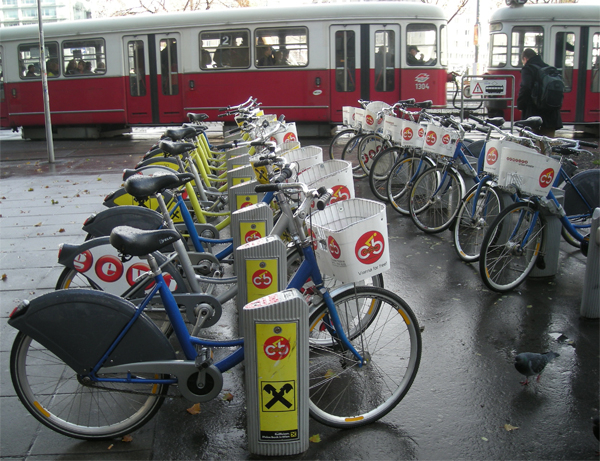 For a tourist who wants to explore the center of Vienna by bicycle, Citybike is great. It also works for locals who both live and work in the city center. Sadly, I work in an area of Vienna that is not covered by the Citybike network and there are no stations near my office. In order to commute to work and back, I would have to rent the bicycle for the entire day, which would be financially prohibitive: The rental costs are calculated on a sliding scale, where the first hour is free, but the second hour is 1 Euro, and subsequent hours are priced increasingly higher. According to this scale, it would cost me 30 Euro per day to commute to work and back - which would of course be madness.
For a tourist who wants to explore the center of Vienna by bicycle, Citybike is great. It also works for locals who both live and work in the city center. Sadly, I work in an area of Vienna that is not covered by the Citybike network and there are no stations near my office. In order to commute to work and back, I would have to rent the bicycle for the entire day, which would be financially prohibitive: The rental costs are calculated on a sliding scale, where the first hour is free, but the second hour is 1 Euro, and subsequent hours are priced increasingly higher. According to this scale, it would cost me 30 Euro per day to commute to work and back - which would of course be madness.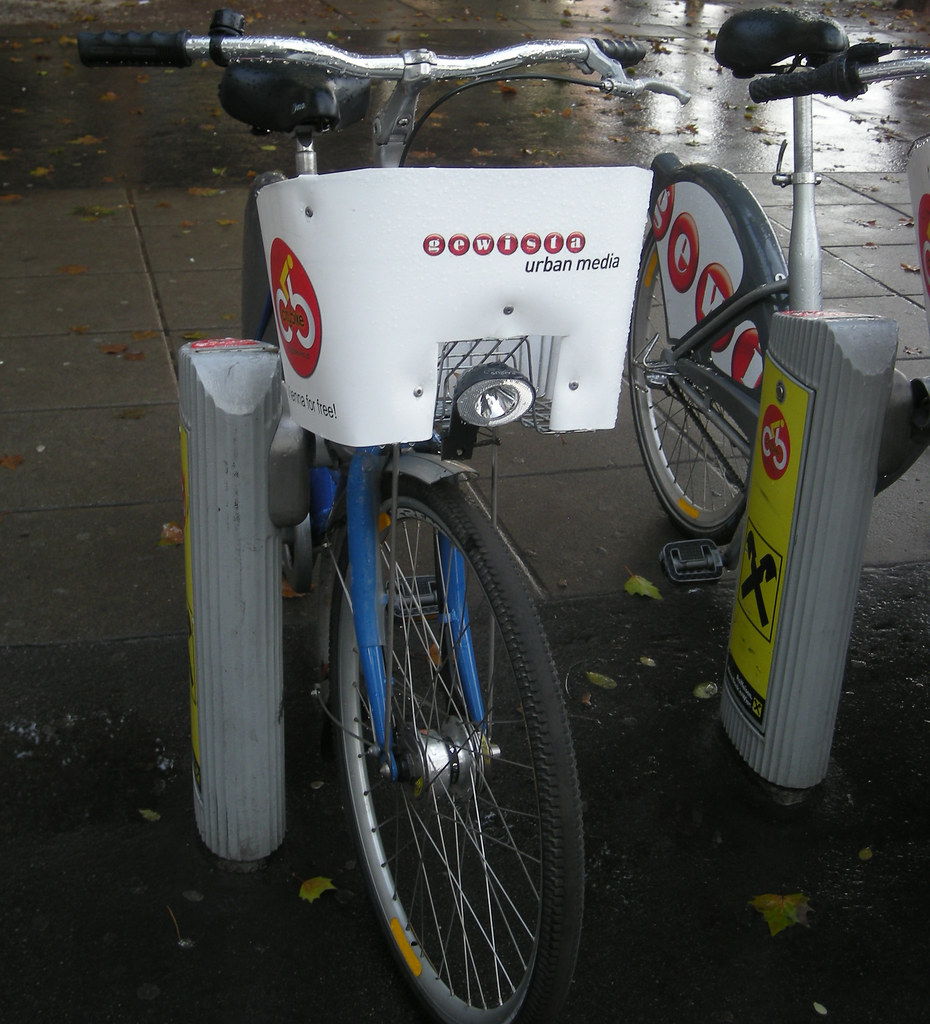 Even to go for a short recreational ride before or after work is not an option, because the bike's basket does not accommodate my work bag.
Even to go for a short recreational ride before or after work is not an option, because the bike's basket does not accommodate my work bag.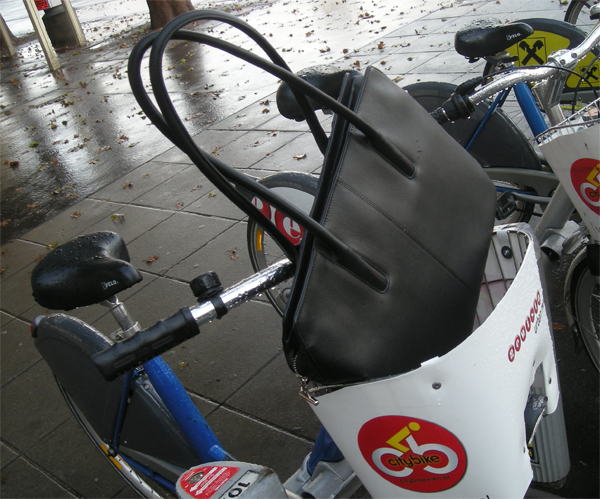 This is the bag I carry to work when I am in Europe. It contains my laptop and the documents I need for the day. As you can see, it does not fit in the basket - and since it's a one-shoulder bag, cycling with it in traffic is not something I want to do. This bag goes with me to official meetings, and switching to a messenger-style bag would not be appropriate in my line of work. I think that any city implementing a bike share programme must take this factor into consideration. In my view, it is a design flaw when professionals are unable to use the bicycles because the basket will not accommodate a standard laptop-sized bag. As you can see below, there is no rear rack either.
This is the bag I carry to work when I am in Europe. It contains my laptop and the documents I need for the day. As you can see, it does not fit in the basket - and since it's a one-shoulder bag, cycling with it in traffic is not something I want to do. This bag goes with me to official meetings, and switching to a messenger-style bag would not be appropriate in my line of work. I think that any city implementing a bike share programme must take this factor into consideration. In my view, it is a design flaw when professionals are unable to use the bicycles because the basket will not accommodate a standard laptop-sized bag. As you can see below, there is no rear rack either.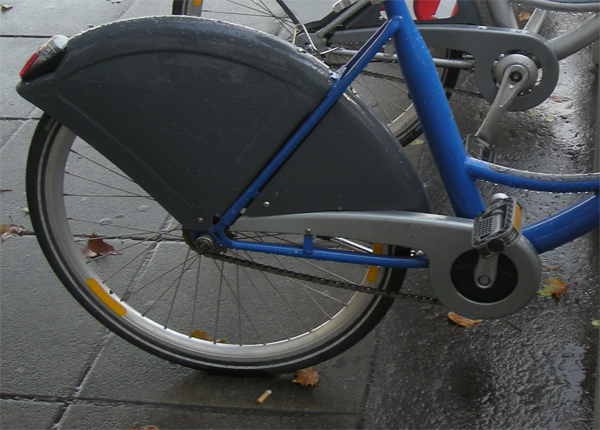 For those who want to cycle in the center of Vienna as tourists, the Citybikes are certainly well fitted for this purpose: step-through frames with adjustable saddle height; swept-back handlebars for an upright sitting position, dressguards, a chainguard,
For those who want to cycle in the center of Vienna as tourists, the Citybikes are certainly well fitted for this purpose: step-through frames with adjustable saddle height; swept-back handlebars for an upright sitting position, dressguards, a chainguard,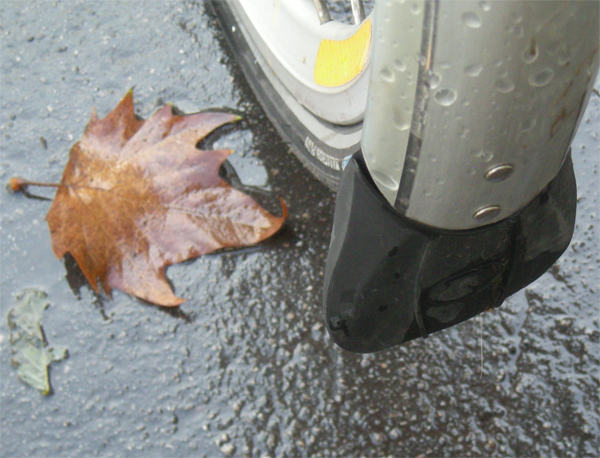 fenders and mudflaps,
fenders and mudflaps,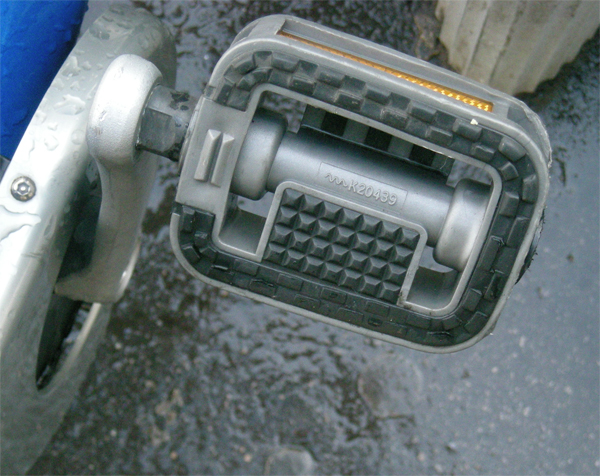 non-slip pedals,
non-slip pedals, a wide saddle with springs that is probably fine on short rides,
a wide saddle with springs that is probably fine on short rides, and the newer Citybikes have 3 speeds, which is sufficient for the central (non-hilly) parts of Vienna.
and the newer Citybikes have 3 speeds, which is sufficient for the central (non-hilly) parts of Vienna. An additional reason I do not rent Citybikes is that, frankly, I do not wish to turn myself into a mobile billboard. In the photo above, you can see the juxtaposition of the Citybike moto "Vienna for free!" (this refers to the first hour of rental being free of charge - though there is still an initiation fee of 1 Euro) and the yellow adverts for
An additional reason I do not rent Citybikes is that, frankly, I do not wish to turn myself into a mobile billboard. In the photo above, you can see the juxtaposition of the Citybike moto "Vienna for free!" (this refers to the first hour of rental being free of charge - though there is still an initiation fee of 1 Euro) and the yellow adverts for 






 Three ofthe quiver with bindings that I think match my use of the ski.
Three ofthe quiver with bindings that I think match my use of the ski.

 Photo courtesy of Glenn Plank and the Plum web site.
Photo courtesy of Glenn Plank and the Plum web site.